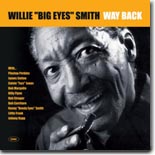 If
you're a serious fan of classic Chicago blues, then I assume you've
already added Willie "Big Eyes" Smith's latest disc, Way Back
(Hightone), to your blues collection. Failure to do so is a serious
oversight. The former Muddy Waters drummer has, in the last several
years, stepped to the front of the bandstand and now fronts his own
band, not to mention the fact that he's become a world class harmonica
player.
If
you're a serious fan of classic Chicago blues, then I assume you've
already added Willie "Big Eyes" Smith's latest disc, Way Back
(Hightone), to your blues collection. Failure to do so is a serious
oversight. The former Muddy Waters drummer has, in the last several
years, stepped to the front of the bandstand and now fronts his own
band, not to mention the fact that he's become a world class harmonica
player.
Smith surpasses his previous solo releases, the most recent being the
excellent Bluesin’ It, released by Electro-Fi in 2004. Reviews of
earlier Smith CDs have pointed out the limited range of his voice. To my
ears, that's not a problem on Way Back. Smith sounds just fine,
and his harp playing continues to get better.
It also helps that producer Bob Corritore, who knows how to get that
vintage Chicago sound out of a modern recording session as well as
anyone in the business, assembled an all-star band for these sessions,
including fellow Muddy band members Pinetop Perkins (piano), Calvin
"Fuzz" Jones (bass), James Cotton (harmonica on two cuts) and Bob
Margolin (guitar on two songs).
It's hard to pick a favorite among the mix of 11 covers and Smith
originals. I'll start with the stark, duo number "Blues and Trouble," on
which Smith's downhome vocals and harmonica are supported by Margolin's
wonderful slide guitar playing. The other number that really did it for
me was the version of Sonny Boy Williamson's "Don't Start Me Talkin',"
with Smith's most inspired vocal work AND some of his best harp.
Smith sets himself up for comparison by covering a Little Walter song,
always a daunting task for any harmonica player. He acquits himself well
on "Tell Me Mama." Sure, he's not in Walter's league, but then who's
ever successfully gone there.
A lesser known Muddy song (St. Louis Jimmy is also listed as co-writer)
is "Read Way Back." This great jump number takes off right from the
first note, driven by Smith's soaring harp.
"If You Don't Believe I'm Leaving" is a Smith original, but it's got a
real Muddy Waters vibe to it. Smith even encourages the band members, à
la Muddy, during the course of the song. Cotton adds great harp work.
There's much more great content on Way Back, but I'll leave you
to discover those songs yourself. Highly recommended!
--- Bill Mitchell
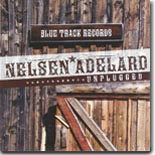 One
of the more underrated artists on the West Coast blues scene is
Nelsen Adelard, who takes his latest disc, Unplugged (Blue
Track Records), in a different direction from his previous independent
recordings. The title aptly describes the CD, with Adelard switching to
acoustic guitar for the eight studio recordings.
One
of the more underrated artists on the West Coast blues scene is
Nelsen Adelard, who takes his latest disc, Unplugged (Blue
Track Records), in a different direction from his previous independent
recordings. The title aptly describes the CD, with Adelard switching to
acoustic guitar for the eight studio recordings.
The album starts on the back porch, so to speak, with nice slide guitar
work on the original, stripped down "Four Winds Blow." After that cut,
Unplugged moves into the front room with an entire band backing
Adelard, who still sticks to the acoustic guitar as well as mixing in
some nice harmonica work.
The better cuts are in more of a jazzy, boogie vein, especially with the
saxophone contributions of Mark Norris. "Boogie Woogie Blue" is a foot
tapping original featuring nice interplay between Adelard's harmonica
and Norris' sax. "Woman By My Side" includes Adelard's most intricate
guitar picking and also features a strong solo from Norris.
One cut that doesn't work as well is the cover of Willie Dixon's "Back
Door Man," in which Adelard tries to take his voice to places that it
wasn't designed to go. Overall, it's a good rendition, but Adelard's
voice isn't powerful enough to handle the shouting vocals. The Muddy
Waters medley, "She Moves Me / Standin' Round Cryin'," better suits his
vocal capabilities, and he nails it with solid singing in front of more
sparse accompaniment.
The inclusion of a ninth song, the live "Don't Stop Now," is a bit of a
mystery. It's a strong number and one that I want to hear again. But
it's with a full electric band, which isn't what this CD is all about.
The song is good enough to stand on its own merits and certainly worthy
of release, but I believe that some other forum would have been more
appropriate than on this disc intended to showcase Adelard's acoustic
side. This is a very minor nit and shouldn't discourage anyone from
seeking out Adelard's Unplugged --- it's a very nice album.
--- Bill Mitchell
Eddie Boh Paris came to Phoenix, Arizona out of Hurricane
Katrina’s disaster. Musicians including New Orleans’ trumpeter Irvin
Mayfield appeared at a Phoenix benefit to raise funds for The Treme
brass band that had migrated, and with which Eddie had taken the
trombone chair. He eventually stayed in the desert to play
professionally, introducing himself: “Call me ‘Chops,’ baby. My
grandfather was a tap dancer, Isaac Mason, with ‘Pork Chop and Kidney
Stew,’ so I shortened my name to ‘Chops.’” Paris also was making
available from the bandstand his fabulous CD AKA ‘Chops’ New Orleans,
LA, explaining how it got to us for review.
Before discussing the CD, it’s worthwhile to relate more of Eddie Boh
Paris’ story: “I feel grateful, as a kid I got into trouble, I’ve been
shot twice, but was basically rescued by New Orleans guitarist and
banjoist Danny Barker and others who took me under their tutelage and
had their eyes on me as someone with musical ability. My instrument
tonight is a marching baritone that sounds like a bass trumpet or
trombone. I also play trombone, sousaphone, valve trumpet, all the brass
and sing.”
The music on the CD is in excellent sound, probably from many sessions
and multiple bands Paris has associated with in the Crescent City. He is
listed as Executive Producer with an additional producer and engineer,
and that’s about it. The tracks start out innocuously enough, permeating
the brass man’s New Orleans identification in short order. The jacket
only identifies his slide trombone, bass trumpet and all vocals. The
drummer(s) is/are very fluid and the bass is laid down by a tuba at
first. There’s non-marching piano and, by track two, electric bass and
guitar. Expected titles include “Bourbon St.” and standard “Sunny Side
Of The Street,” plus “Found A New Baby,” then the disc goes up a notch
in adventure to rival some of the best known contemporary brass bands
out today, like Dirty Dozen. By this we mean combining, say, traditional
brass band instrumentation from 100 years ago, but having them riff on
Lester Young of the bop ’40s .
“Iko” is married to “Funky Stamps” and it’s here where harmonic ground
gets pushed, as does drive. “Whooping Blues” is (I think) Bessie Smith
which evolves into super syncopation, anchoring solos by both tenor and
alto saxes. Stereo separation is so alive and effective on the old “St.
Louis Blues” that it may be two bands duking it out. Professor
Longhair’s whistling is imitated on his “Mardi Gras,” but it’s “O’ Lil
Liza” that purees the rhythm in multi-micro directions a la Louie
Prima’s hits. More predictable New Orleans brass sounds return to wind
down the program followed by the delightful “Miss Lady” (female-themed
titles seem to stand out), encompassing more recent decades of pop
influence and a wonderful modulation at end. The disc wraps with Louie’s
“Wonderful World,” yes often-done, but Eddie receives high marks with
his individuality and evidence of respect.
This CD is definitely creative, ground-cutting, and above all, fun.
Write to Eddie for availability:
eddiebparis@hotmail.com.
---Tom Coulson
Radio broadcaster/musician
comments to tcoulson@ktar.com
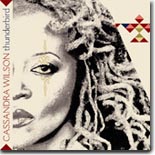 Except for early jazz piano trio recordings, Cassandra Wilson's
image has always guaranteed eclecticism. Her understated and delicate
low-range vocal has traversed many producers and albums since, feeling
almost folk rather than jazz or blues but at once integrating
contemporary and adventurous elements. She has covered Joni Mitchell,
for example, quite admirably. This has caused her current star to shine
quite brightly toward the public, while probably equally respected among
musicians. No one seems to agree with me, but she’s similar to the late
Nina Simone in voice, not controversial politically but maybe in style.
Except for early jazz piano trio recordings, Cassandra Wilson's
image has always guaranteed eclecticism. Her understated and delicate
low-range vocal has traversed many producers and albums since, feeling
almost folk rather than jazz or blues but at once integrating
contemporary and adventurous elements. She has covered Joni Mitchell,
for example, quite admirably. This has caused her current star to shine
quite brightly toward the public, while probably equally respected among
musicians. No one seems to agree with me, but she’s similar to the late
Nina Simone in voice, not controversial politically but maybe in style.
She seems to have recorded blues material first on the 1995 album New
Moon Daughter in a single track, Son House’s “Death Letter.” It is
eerie, hypnotic and at the same time warm. One critic applauded her for
not shunning her southern roots (born 1955, Macon, Georgia).
From that spark seems to have evolved a direction and identity directly
traceable to Thunderbird (Blue Note Records), which hit stores
April 4, 2006. She has been teamed with producer/guitarist/vocalist
T-Bone Burnett, which should bring her an even wider audience. A plus is
Burnett utilizing electric slide guitar often during the album,
authenticating its blues quality and helping Wilson’s image evolve. But
a minus is one of the producer’s trademarks, an over-processed low-end
to the sound. Ms. Wilson’s voice should be supported and enhanced, not
forced thru the bass speakers of a passing low-rider. I can do without
the thumping.
In addition, the album as a whole is rather weak in the groove dept. Not
that rhythms are over-complicated or limpid, but maybe too much
in-between. For example acoustic bass is used on certain tracks but then
underlined by either an additional electric bass or keyboard. When the
drummers play they are rigid and don’t breathe, and are interspersed
with electronic sampling. Why use real musicians when the result is so
mechanical and perfect?
The catchiest and most hum-able of the tracks is the lead-off “Go To
Mexico.” It is rich with production elements, overdubs, probably upright
piano like an old Beatles record, and background vocals. That same piano
continues in track two, and the “drum machine with thumping” effect
again underlines, but Cassandra’s very melodic vocal ability is intact.
Track three has a long-suspended intro resolved into slow, but heavy
rhythm. By the track four the tempo is similar, the backbeat having a
handclap effect. After the classic “Red River Valley,” sans rhythm, it’s
obvious the album is not going to gain a lot of momentum. “Poet” has
some polyrhythms mixing things up behind a big marching bass drum, but
that only adds to the irritating drone that the electronics already
provide elsewhere.
Cassandra is to be commended for writing six of the ten album tracks,
which meld well together. Muddy Waters’ “I Want To Be Loved” is
compatible with both the vocalist’s and producer’s styles, but even
Wilson sounds awkward duplicating Muddy phonetically --- “I WANTS to be
loved...” The duet between Wilson and Burnett, “Lost,” works absolutely.
If anything were to document her progress to the moment, it would be
this track. It’s HER. The album concludes with a couple more studio
adventurous productions: The rather dark “Strike A Match” in 7/4 time
with stops and a cello effect, and “Tarot,” utilizing acoustic guitar
and sounding almost Brazilian.
Cassandra Wilson has come a long way and has earned her hopefully
still-fledgling success. This album does earmark the seasoning and
wisdom she has earned along the way, but also seems a distance from any
high-water mark. Though back in ‘95 when she was all over the map
covering the Monkees, Neil Young, U2, Hoagy Carmichael, Hank Williams
plus her own originals in a single album, the musicians and production
elements still felt more organic than now.
---Tom Coulson
Radio broadcaster/musician
comments to tcoulson@ktar.com
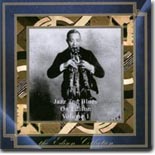 One problem with some vintage music is that it’s released due to either
antique special interest, or for the repackaging of previous
big-sellers, and sometimes producers have no clue as to how to deal with
one or the other. Jazz and Blues on Edison, Volume 1 (Document
Records) is an excellent 16-page liner note booklet is clear-cut. Edison
didn’t like jazz (“I always play jazz records backwards, they sound
better that way”) but recorded quite a bit, and apparently released
some. Most of these artists are totally obscure and almost all the
material has never been released until now. What does this tell today’s
jazz/blues enthusiast? Probably that this is not what the public heard
or was buying at the time, but rather what the day’s musicians
considered fun, more spontaneous and out of the ordinary, since the
categories of records then were classical (including folk), hits (pop),
“race” (precursor of jazz/blues/R&B) and “hillbilly.”
One problem with some vintage music is that it’s released due to either
antique special interest, or for the repackaging of previous
big-sellers, and sometimes producers have no clue as to how to deal with
one or the other. Jazz and Blues on Edison, Volume 1 (Document
Records) is an excellent 16-page liner note booklet is clear-cut. Edison
didn’t like jazz (“I always play jazz records backwards, they sound
better that way”) but recorded quite a bit, and apparently released
some. Most of these artists are totally obscure and almost all the
material has never been released until now. What does this tell today’s
jazz/blues enthusiast? Probably that this is not what the public heard
or was buying at the time, but rather what the day’s musicians
considered fun, more spontaneous and out of the ordinary, since the
categories of records then were classical (including folk), hits (pop),
“race” (precursor of jazz/blues/R&B) and “hillbilly.”
It’s marketed now as Jazz and Blues on Edison and that seems
appropriate. At the time a Louis Armstrong or Bessie Smith were in the
same category, whereas today purists certainly call one jazz and the
other blues. And though most of the obscure music here hasn’t been
available until now, it was still recorded by Edison. So you’ll hear the
category lines blurred within the tracks, then hear jazz popping out
here and a minor key blues there. As other pioneer labels were taking
equipment to regions to record undiluted folk sounds, the Edisons here
were all apparently recorded at its West Orange, New Jersey studio,
possibly explaining their more urban polish.
Another personal problem I have with vintage jazz recordings is quite
frankly having too much tuba and/or banjo, and silly things like
high-trill clarinets and kazoos are too much. This has tended to make
the music cornier, especially ruining the novelty tunes of the time.
Fortunately Edison was a major corporate player (with a fledgling
Columbia and also Victor as competitors) in the marketing of music, and
this release indicates Edison Records was focused on high quality,
including musicianship and recorded sound. The problems just mentioned
are minimal on this CD and the overall picture turns out to indeed have
much musical value, harmonically adventurous and in-tune. Yes, you’ll
hear Andy Razaf’s ridiculous vocal in an attempt to sound society white
on “Hot Tamale Baby,” but the producers are creative by following that
immediately with Marjorie Royer’s version of “Hard-Hearted Hannah,” a
tale of a baby not so hot. Interesting also is a possible precursor to
“Sweet Georgia Brown” in chord structure, “Since My Best Girl Turned Me
Down,” by Winegar’s Penn Boys.
Among the known musicians in this collection are Wilbur Sweatman
(pictured on the cover--once employed a young Duke Ellington and
sounding the jazziest of the bunch), Rosa Henderson, and Noble Sissle/Eubie
Blake. There are also period or regional stars Georgia Melodians,
Clarence Williams and Mal Hallet, a Humphrey Bogart look-alike who
conducts the final track with an orchestra in a style forward-looking to
the swing era, including a trace of walking bass (tuba) under a sax solo
on “Wang Wang Blues.” The various-sized group leaders among the tracks
are multi racial, but it’s highly unlikely that way within the groups
themselves, given the era.
For the story of how the Edison recordings survived and finally came to
release go to
http://edison-project.50megs.com. There you’ll also find the link
“Biographies On Selected Edison Artists” with most names on this disc
profiled. May we also encourage indulging yourself at the Document label
website
which specializes in pre-World War II recordings like these (an entire
separate article could be written on the label and founder Johnny Parth
of Austria, who I once heard speak at a Memphis convention).
A few technical comments: Edison was apparently the pioneer record label
ever, with Thomas himself at the helm, beginning with cylinders in the
1800s. The range here starts in 1914, two years after the generally
regarded first jazz records, when the discs were very thick and groove
frequencies went up and down in what they called vertical-cut. The end
is 1929, when Edison stopped making records. By this year the company
was using the refined lateral-cut method, i.e. back-and-forth grooves
that lasted into the LP era. There is no indication as to which of these
selections were recorded acoustically (megaphones) or electronically
(microphones) of which the industry was transitioning in the ‘20s.
But the best summary of the modern technology of the day is sung in the
words of Elsie Clark, the only artist omitted in the CD’s liner notes,
on the track “Loud-Speakin’ Papa:” --- "Lucy Lee from Tennessee, went
and bought a radio set, she also had as a household pet, the
loudest-speaking papa I’ve heard yet.
He talked tough, acted rough, and strutted his material proud, he’d rave
and shout out loud, he always sounded like a crowd. One night he bawled
her out about her radio, that made miss Lucy angry and she told him so,
she said ‘Loud-speakin’ papa, you’d better speak easy to me.’ Some day
you’ll shout and then no doubt, I’m gonna turn your dial and tune you
out. I don’t have to listen to your noise and din, just find the other
stations and tune right in. You’re listening now to station W-I-F-E,
you’re mama is announcing, listen carefully. If you get mama angry sure
as you are born, I’m gonna twist your aerial and buck your horn. I don’t
like what you’re broadcasting anyhow, your program’s getting stale it’s
full of static now. You know you’re mama’s got an awful powerful set,
and there ain’t no place that she can’t get.”
---Tom Coulson
Radio broadcaster/musician
comments to tcoulson@ktar.com
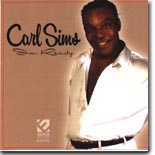 I'm Ready is the second Carl Sims release for Ecko, and it
is even more enjoyable than his earlier release, It's Just a Party,
reviewed here in our December 2004 issue.
Although most of the tunes are mid tempo dancers, as the excellent "I
Need A Woman" opening track will reveal, there are also a few memorable
soul ballads. The '70s sounding "I'm A Hustler," with its stark lyrics
"I'm a pimp, a player and a lover too," is a tune that will be culled
for radio play, as will the stylish dance tune "Step to The Left," with
its real drums and catchy hooks.
I'm Ready is the second Carl Sims release for Ecko, and it
is even more enjoyable than his earlier release, It's Just a Party,
reviewed here in our December 2004 issue.
Although most of the tunes are mid tempo dancers, as the excellent "I
Need A Woman" opening track will reveal, there are also a few memorable
soul ballads. The '70s sounding "I'm A Hustler," with its stark lyrics
"I'm a pimp, a player and a lover too," is a tune that will be culled
for radio play, as will the stylish dance tune "Step to The Left," with
its real drums and catchy hooks.
"The Memories" is Carl Sims at his best --- smooth sounding, mature
vocals on this superb ballad. I first heard Carl Sims with his 1994
Paula release House of Love, with its classic "Shot To The Curb,"
and one of the finest versions of Sam Cooke's "A Change Is Gonna Come."
I've been a fan ever since. It's hard to believe it's been 12 years
since that release.
An interesting footnote in Sims' career was back in the mid-60s when he
was the teenage lead singer for the original Bar-Kays. The Bar-Kays took
Arthur Conley's place as opening act for the Otis Redding Review. A
plane crash in Milwaukee in 1967 killed Otis and several of the Bar-Kays.
Sims, along with another band member, luckily took a commercial flight
out of Cleveland to join the group later because there was no more room
in Otis' private plane. Carl remembers having to identify the bodies of
the band members. After returning to Memphis along with surviving
members Ben Cauley and James Alexander, what was left of the Bar-Kays
went their seperate ways.
Over the years Carl Sims has emerged as one of the premier southern soul
singers. Each new release will be greatly enjoyed by his legion of fans
worldwide.
--- Alan Shutro
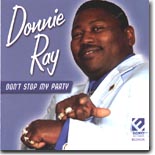 Donnie Ray Aldredge was born in Texarkana, Texas on July 4, 1959. By the
time he was 15 he was performing in his father's band. It was with that
band, the Aldredge Brothers Band, he learned to play the guitar, and
soon after he was not only a singer but an instrumentalist as well.
Donnie Ray understood the importance of versatility as he mastered
lead and bass guitars, the keyboard and also the drums.
Donnie Ray Aldredge was born in Texarkana, Texas on July 4, 1959. By the
time he was 15 he was performing in his father's band. It was with that
band, the Aldredge Brothers Band, he learned to play the guitar, and
soon after he was not only a singer but an instrumentalist as well.
Donnie Ray understood the importance of versatility as he mastered
lead and bass guitars, the keyboard and also the drums.
Donnie Ray's first CD, Let's Go Dancing on the Suzy Q label
contained his first hit song, "Letter To My Baby." A couple of years
later they released Are You Ready For Me, which did well on the
southern soul market. He signed with Ecko Records in 2005.
Don't Stop My Party is his second Ecko release and is one of the
best this enterprising label has released to date. From the drum intro
on track one "Is It Your Place or Mine" to the soulful ballad "Seven
Long Years," or to the title track "Don't Stop My Party," a stepper that
is getting a lot of club plays, the exceptional quality of this release
is apparent.
"Sweeter To Me" is a retro sounding track that would have made Tyrone
Davis proud. "Back Up And Try It Again" , "Sexy Lover" and "Sexified"
are all club dance tracks that are on an even par with the rest of the
club tracks here. "Can I Talk To You," with its spoken intro (I'm
a sucker for those), oozes with soul, and Donnie's smooth vocals and the
addition of some fine background singing raises this track to the top of
my favorites here.
If you want a sample of what great modern southern soul is all about,
you won't go wrong starting here.
--- Alan Shutro
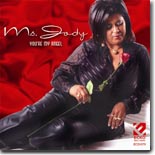 Ms. Jody of Bay Springs, Mississippi is one of Ecko's newest
artists. Although she has been singing all her life, Ms. Jody did not
attend her first blues show until Father's Day 2004, when her brother
Dale Pickens took her. That day she saw Denise LaSalle and O.B. Buchana;
she was so moved by the performances that she decided she wanted to be a
performer too. Everything moved pretty quickly after that. In 2006, at
the suggestion of her friends, Ms. Jody made a visit to Ecko Records to
meet with the staff. Shortly thereafter she joined the Ecko Records
family and You're My Angel, her first CD, was released.
Ms. Jody of Bay Springs, Mississippi is one of Ecko's newest
artists. Although she has been singing all her life, Ms. Jody did not
attend her first blues show until Father's Day 2004, when her brother
Dale Pickens took her. That day she saw Denise LaSalle and O.B. Buchana;
she was so moved by the performances that she decided she wanted to be a
performer too. Everything moved pretty quickly after that. In 2006, at
the suggestion of her friends, Ms. Jody made a visit to Ecko Records to
meet with the staff. Shortly thereafter she joined the Ecko Records
family and You're My Angel, her first CD, was released.
Anyone who takes her name from the soul/blues folklore legend Jody had
better be able to convincingly deliver the goods, and she comes out
swinging on the first track, her adopted namesake, "Ms. Jody." She
alludes to Marvin Sease (The Candy Licker) and proceeds to strut her
stuff for five minutes. Well, O.K. you got me for five minutes, but what
about the remaining 40 minutes?
I'm afraid to report that this Jody sort of got soft after only five
minutes. I mean, what true Jody only keeps it up for five minutes? The
remaining ballads and shake your booty tracks didn't really cut it. In
fact they were pretty faceless and really nothing you want to return to
other than track one. Hopefully, next time she'll earn the right to the
Jody tag. Until then she's just a pretender to the throne.
--- Alan Shutro
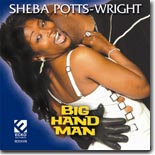 It's hard to believe that Big Hand Man is Sheba Potts-Wright's
fourth album already. It seems like only a few months ago I was
reviewing her first one (it was actually Blues Bytes issue of
October 2001) and since then she has become
one of Ecko's most consistent performers. She had two hit singles in
2005 with "I Need A Cowboy To Ride My Pony" and the weirdly titled "I
Can Hear Your Macaroni," and her recordings of "Slow Roll It" and the
ever popular "Lipstick On His Pants" still are played on the radio
almost every time you tune in to WDIA in Memphis.
It's hard to believe that Big Hand Man is Sheba Potts-Wright's
fourth album already. It seems like only a few months ago I was
reviewing her first one (it was actually Blues Bytes issue of
October 2001) and since then she has become
one of Ecko's most consistent performers. She had two hit singles in
2005 with "I Need A Cowboy To Ride My Pony" and the weirdly titled "I
Can Hear Your Macaroni," and her recordings of "Slow Roll It" and the
ever popular "Lipstick On His Pants" still are played on the radio
almost every time you tune in to WDIA in Memphis.
Big Hand Man follows the tried and true path laid out by those
previous successes. Most of these tracks have the usual sexual innuendos
and double entendres that make her releases so popular. "Private Fishing
Hole," "If You Don't Want My Love," and "Don't Get Yours Before I Get
Mine" are all getting loads of airplay, and of course so is the title
track, "Big Hand Man." That track instructs the ladies that if a man has
big hands and big feet, he is a good bet to have a big ......(no, not
heart). One other cut I might mention is "Knock On Wood," a mid tempo
dancer with a great hook, and no it's not the same "Knock On Wood" that
Eddie Floyd made so popular.
It's been many years since I saw Sheba open for Denise LaSalle. That
young lady has certainly matured into a very fine looking woman as you
yourself can see when you purchase this CD, and check her out on the
back tray insert. In addition to that photo, you'll get ten great new
tunes to enjoy, too. What a deal. Way to go girl. More hits are on their
way.
--- Alan Shutro
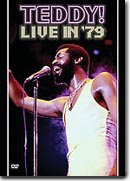 This
1979 live concert, appropriately named Live in '79 (Shout Factory
DVD), recorded at The Sahara in Lake Tahoe, NV on February 2, 1979 is a
testament to the tremendous talent Teddy Pendergrass was at this,
the zenith of his performing career. That career was seriously derailed
when Teddy was paralyzed in a 1982 car crash.
This
1979 live concert, appropriately named Live in '79 (Shout Factory
DVD), recorded at The Sahara in Lake Tahoe, NV on February 2, 1979 is a
testament to the tremendous talent Teddy Pendergrass was at this,
the zenith of his performing career. That career was seriously derailed
when Teddy was paralyzed in a 1982 car crash.
His recording career began as the lead singer of Harold Melvin and The
Blue Notes in the late '60s, when the group had numerous hits, including
the 1972 number one R&B hit, "If You Don't Know Me By Now." Teddy left
the group in 1976 to begin a sucessful solo career. With songs like
"Close The Door" (included here), which hit the number one spot in 1978,
along with chart toppers such as "Love T.K.O." and "Turn Off The Lights"
(not included), he was one of the major performing artists of his time.
This DVD covers songs from the early part of his solo career along with
a medley of tunes he sang with Harold Melvin & Bluenotes. From the
opening "Life Is A Song Worth Singing," you will be captivated by this
great performer. There is also a special interview with him in his home
near Philadelphia, which is quite moving, covering not only his musical
career, but also with his learning to live with and overcome the
limitations of his disability.
This is an essential release and one that should be in every collection
of fine musical DVDs. No history of soul music would be complete without
the inclusion of the great Teddy Pendergrass.
--- Alan Shutro
Shaped under the pressure of being in the bands of
Willie Dixon, Muddy Waters, and Magic Slim, John Primer has become an
electric Chicago blues master. In 1963, he relocated from Mississippi
and has slowly secured his place in the blues pantheon. Primer just may
be the last great American bluesman. Together with his Real Deal Blues
Band, they sound like troubadours from Muddy Waters’ greatest bands.
Filmed on February 11 and 12, 2005 by a friend
and family member (who sometimes get caught on film), the DVD Live at
B.L.U.E.S. (independent release) did not
have a Hollywood budget. There are no extra features and the sound is
not a 5.1 mix. As a bonus, there are four songs that have not been
previously recorded on Primer’s other releases. Just like being at the
club, the heads of patrons occasionally block your view of the stage and
background chatter can be heard. Yet, the comforting essence of Primer’s
music and an authentic Chicago blues club has been captured.
Primer knows exactly where he is going on guitar.
All you need to do is follow. His unheralded slide work is not retching or wild;
it is simply impeccable on "I Held My Baby" and the opening
shuffle, "I’m Worried." Here, Dave Ross’ piano solo is pristine,
while Dan Beaver impressively blows harp like Little Walter. Also
reprised from Primer’s recent Elmore James tribute CD, Blue Steel,
is "Fine Little Mama." In all, nine covers are included from the
likes of Robert Johnson and Magic Sam.
Primer’s assertive voice is
sensitive on the low tempo "Walking Blues." The song is
traditionally performed as if Primer was still in Waters’ band. Ben
Harper’s "Steal My Kisses" comes out on top as it is given a
hypnotic Primer guitar groove. It invites you to listen, makes you feel
welcome, and ensures you stick around. The other number with a fresh
sound is John Mayer’s "C.O.D." "Somebody Have Mercy" contains
an extended and concise guitar solo that features Primer wandering out
on to North Halsted. He returns and takes you out like a freight train
on the closer, "Mojo Working." Throughout, Primer does not exhibit
much stage presence due to the restriction of the tiny bandstand. It is
so small; the keyboards had to be set up on the floor. Watching this DVD
is the closest many will get to experiencing 1950s style Chicago blues.
--- Tim Holek
Freelance Journalist
www.timholekblues.ca
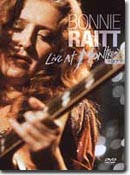 The Montreux Jazz Festival began in 1967 and
has become an esteemed music festival. Eagle Vision now has a Live
At Montreux DVD concert series. Notoriety had escaped
27-year-old Bonnie Raitt at the time of her first Montreux appearance on
July 23, 1977. Absorbed in the blues since college, she began her
boundless career as a solo acoustic slide guitar act performing country
blues. This interested Mississippi Fred McDowell and Son House, and lead to
a signing with Dick Waterman and Warner Brothers.
The Montreux Jazz Festival began in 1967 and
has become an esteemed music festival. Eagle Vision now has a Live
At Montreux DVD concert series. Notoriety had escaped
27-year-old Bonnie Raitt at the time of her first Montreux appearance on
July 23, 1977. Absorbed in the blues since college, she began her
boundless career as a solo acoustic slide guitar act performing country
blues. This interested Mississippi Fred McDowell and Son House, and lead to
a signing with Dick Waterman and Warner Brothers.
Raitt’s 11-song set
features rock, pop, and ballads from her first six albums. Given its
age, the video images are exceptionally good, though horizontal lines
are occasionally visible. Many views are from the front row. They are
too close – making you want to zoom out. The digitally re-mastered audio
was originally recorded on analog tape, which accounts for the scratchy
vocals and hiss. Although recorded live, the engineers captured the
sound of a 1970’s Los Angeles studio.
At first glimpse, Raitt – dressed in ’70s era
bell bottom jeans – looks a crossbreed of Janis Joplin and Linda
Rondstat. Raitt is homesick as she mentions U.S. states and cities, and
how nervous she is to play Europe for the first time. Her disciplined
band features Freebo (bass/tuba), Dennis Whitted (drums), Will McFarlane
(guitar), and specialist Marty Grebb (keys/sax). You can tell without
reading the credits that the
folk-rocking "Under The Falling Sky" was written by Jackson Browne. On it, Raitt breezes through several tempo
changes. Some other songs carry Delaney and Bonnie and Dave Mason
traits.
A sprinkle of reggae and get down dance riffs are added to
"Good Enough." Thanks to the chorded harp solo of guest Jerry Portnoy, "Love Me Like A Man" contains the most blues. Easy rolling rhythms
with ragtime feel is present on "Give It Up, Or Let Me Go." The
burlesque "Women Be Wise" is performed as a tribute to Raitt’s late
1960s mentor Sippie Wallace. No"thing Seems To Matter" is a
sensitive song, which feature Raitt’s diffident vocals. Raitt plays
signature unerring slide on "Sugar Mama" before the encore "Runaway." Ironically it was Raitt’s first radio hit but it doesn’t
meld into her repertoire.
Her image, songs, and band are dramatically
different on the four bonus cuts from her second Montreux appearance on
July 10, 1991. The wide screen, high definition cinematography and sound
quality are greatly improved. Her larger group contains no band members
from the ’70s show. Now a mature-looking woman, and Grammy Award winning
musician, Raitt is confidently at home with her foreign audience. Her
refined vocals are superior on these cuts. The upbeat and polished songs
feature Americana roots rock on "Papa Come Quick" and special guest
Charles Brown on "Think." Those unfamiliar with Raitt will enjoy
the 1991 performances, but the 1977 concert documents a piece of
history.
--- Tim Holek
Freelance Journalist
www.timholekblues.ca
Why hasn’t anyone written a book about Bobby Rush?
He has many stories to tell. The sincere songs on Raw To The Bone
(independent release)
display his innate ability to tell stories. Educated by some of the
genre’s finest, Bobby left his imprint on the
mighty Chicago blues scene, created his own folk funk style, and has
been crowned the "King of the Chitlin Circuit." Now 72, Rush has
recently crossed over to a wider audience. “I was told I couldn’t
crossover without changing my image. I didn’t believe that. I’m a black
man who plays the blues. What you see is what you get. I’m just being
Bobby Rush, a plain ole country boy.” Shawn Kellerman hails from
Kitchener, Ontario, and is a contemporary blues guitar virtuoso. His
style of guitar reinterprets the traditional forms and blasts them into
the present.
There are two sides to Bobby Rush the master
showman. One comes with booty shaking chorus
girls, risqué material, and flamboyant costume changes. The
other, as portrayed here, involves old-fashioned grooves from the hills
and jukes. Raw To The Bone (his fifth CD released within
the last three years) was recorded at Rush’s home on Kellerman’s laptop.
The 13 laid-back and relaxed songs were written by Rush, yet many of
them sound familiar, e.g., "What’s The Use" sounds like "No
Cutting Loose."
The 52-minute CD features bare bones blues performed
in the traditional 12-bar format. Exposing only Rush’s full-bodied
harmonica, "You Don’t Love Me" and "I’m Tired" may be the
barest of them all. "Boney Maroney" is a departure from his usual
lovin’ a big fat woman shtick. The song, about a (“little skinny
woman”), has a catchy yet simple rhythm and Bobby’s real deal blues
harp. That ultra rousing rhythm is repeated on "Uncle Esau," which
sounds like "Chicken Heads."
Kellerman sharply picks and strums on "School Girl." He plays a dirty Mississippi rhythm on
"Glad To
Get You Back" while Rush performs satisfying harp. As on "Howlin’
Wolf," the lyrics (“howlin’ so long, done made my tonsils sore”) are
entertaining. All along, they are not as raunchy as you might expect.
However, if you didn’t know the real Bobby Rush – he has been married to
the same woman for over 40 years and is very active in local charities –
you’d mistake him for a lying, cheating sex maniac on "I Got Three
Problems."
Rush plays guitar, chromatic and diatonic
harp, and clomps his feet to keep the beat. His unobtrusive vocals sound
like they are in conversation with you. Throughout, Kellerman maturely
plays the role of dependable sideman, yet on "What’s Going On" he
cuts his strings like the Delta masters. Performing acoustically –
especially when it only involves two guitars, a harp, and a vocalist –
is difficult because listeners focus intently. Creating a memorable and
energized acoustic CD – like this one – is even more admirable. Purists
will be pleased with this permeating product, although it may be a bit
hard to find. It’s available off the stage or by contacting Shawn Kellerman by email via
www.shawnkellerman.com
--- Tim Holek
Freelance Journalist
www.timholekblues.ca
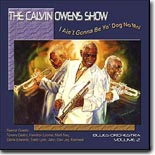 I’m beginning to believe that Calvin Owens is a genius. He’s utilizing
his orchestra to support four diverse recording projects all at the same
time and the results are wonderful. The formula is simple: assemble the
best group of musicians you can find (he has), throw in some talented
guest artists (Tommy Castro, Harold Loomis, Trudy Lynn), pick diverse
material that showcases the talents of the band (he did), and make sure
we all listen to it (now that’s the hard part). But no matter how you
slice it, Ain’t Gonna Be Yo’ Dog No Mo is another great blues
release featuring the Calvin Owens Blues Orchestra.
I’m beginning to believe that Calvin Owens is a genius. He’s utilizing
his orchestra to support four diverse recording projects all at the same
time and the results are wonderful. The formula is simple: assemble the
best group of musicians you can find (he has), throw in some talented
guest artists (Tommy Castro, Harold Loomis, Trudy Lynn), pick diverse
material that showcases the talents of the band (he did), and make sure
we all listen to it (now that’s the hard part). But no matter how you
slice it, Ain’t Gonna Be Yo’ Dog No Mo is another great blues
release featuring the Calvin Owens Blues Orchestra.
I like the fact that this record opens with an Owen composed
instrumental, “Mr. Handy.” I immediately hear clarinets, supporting
horns, the trumpet leads of Calvin himself and I know the best is yet to
come. The sound of Tommy Castro’s strat lets me know that he’s a part of
the next cut, “Never Saw It Coming.” Tommy lends his vocal talents as
well is this tale of love of a good woman sneaking into his life without
him really realizing it.
Hamilton Loomis plays lead guitar and contributes his vocal talents to
“Best Worst Day.” Hamilton laments the fact that the woman in his life
is driving him crazy but the loving is too good for him to give up. The
result is the “best worst day of my life” and he’s just going to have to
take the good with the bad. Trudy Lynn pleads to her lover, “Just Be
True to Me,” while singing her heart out on the next song, a Rue Davis
original. The boy must be good to have Trudy tell him…”you can tease me,
please me…just be true to me!” As long as her man treats her right he
will always be happy.
The inclusion of Zydeco is a rare treat with the Texas Prince of Zydeco,
Jabo, contributing his accordion talents to “Hold What You Got.” As long
as “you hold what you got you’ll get what you need!” An astute choice by
Calvin, the up tempo styling of “Hold What You Got” is contrasted with
classic big band instrumentation on the Charles Brown classic, “Black
Night.” Soulful vocals tell this tale of despair by a man whose woman
has left him to dwell in his own misery.
“Handcuffed to the Blues” features a rap intro by Rasheed and vocals by
Gloria Edwards. Her punishment for abusing love is to be “handcuffed by
the blues.” She’s miserable because good love is the only key that will
free her from all of the hurt she’s inflicted on the lovers in her past.
Leave her cuffed…it serves her well. Mark May lights up his guitar intro
on “So Mean to Me” and admonishes his woman to leave him alone if she’s
going to be ...”so mean to me!” I find the guitar work of May, Castro
and Hamilton all lend different shadings to this recording and were
astute choices to be guest artists by Calvin Owens.
Next up is the instrumental, “Magic Stick,” and a chance to bring
Calvin’s trumpet to the forefront. “Magic Stick” is a classic
performance that is aided in part by intricate keyboard work and
wonderful clarinets. Tommy Castro then makes his second appearance and
brings us back to blues reality by letting us know that it’s “Time to
Rock.” One of the things that stand out on “Time to Rock” is the
orchestral score by Calvin in support of Tommy and that’s the real
genius of this entire record, wonderfully supporting orchestral
instrumentation. You can’t beat it.
Gloria Edwards returns with the charming “Nobody Ever Loved Me” to let
us know that nobody has ever loved her like her current man does and
that’s ok. Gloria gives a great vocal performance that is followed by
the keyboard genius of David Maxwell on “Mr. Maxwell”. “Mr. Maxwell" is
my favorite instrumental track on the record and is wonderfully played.
Attitude reigns supreme with Davi Jay singing the lead on “I Aint’ Gonna
Be Yo Dog No Mo.” He laments that he doesn’t “want to be yo dog no
mo’…..I want to be your man” and of course his woman doesn’t feel he’s
being treated that badly. Here’s hoping he gets some respect. The Texas
Prince of Zydeco, Jabo, takes the microphone for “You Didn’t Hurt Me,”
the final Rue Davis song on the record. Jabo does a nice job of letting
his woman know he’s moved on to someone better….someone who treats him
right….and that in the end “you didn’t hurt me!”
Calvin and the orchestra close everything out strong with their
rendition of “Sweet Angel.” Calvin was once part of B.B. King’s
orchestra and I like his choice of “Sweet Angel” as the final cut of
I Ain’t Gonna Be Yo Dog No Mo’.
Calvin Owens and his Blues Orchestra give us another classic recording
that we rarely hear anymore. It’s extremely difficult to sustain a large
orchestra in this day and age and I applaud Calvin for his efforts. He’s
true to his vision and we’re better off because of it.
You can find this and all of his recordings at
www.calvinowens.com.
Pick up a CD and take a listen. We all have different tastes in our
choices of blues artists, but you can’t help but appreciate the efforts
of Calvin and his orchestra in their sincere desire to entertain us.
You’ll be glad you did.
--- Kyle Deibler
I hate to admit it, but at first blush the latest release by the
Daddy Mack Blues Band, Slow Ride, just didn’t appeal to me.
I’m a firm believer that as blues lovers and players, we all need to
stretch the boundaries of this genre we love so much. That’s why
initially the concept of a bluesman reversing the rock n” roll royalty’s
constant borrowing from the blues by giving his take on rock songs left
me scratching my head. As I began to read the liner notes and the
accompanying press release, I realized that a majority of the band
members were at one time part of Memphis’s legendary band, the
Fieldstones. I did the only thing I could do --- closed my eyes, kicked
back and just listened.
What I found was a record that passed the listen test. Strong guitar
playing by Daddy Mack Orr, wonderful support by Billy Gibson on the
Mississippi saxophone and solid support from the rest of the band allow
Daddy Mack to dive headfirst into some of the best rock songs ever
written and ensure that all of their blues roots were exposed. We hit
the ground running with Billy’s harp intro on “Slow Ride” and I decide
I’m on-board for this adventure.
Things start to make sense to me on “Whole Lotta Love.” Daddy Mack
didn’t pick up a guitar until he was into his 40s but the groove on
“Whole Lotta Love” indicates that he learned well. Slow and
passionate…with a touch of harp thrown in by Billy Gibson…and you’re
sure that Daddy Mack has a whole lot of love to share with his woman.
“After Midnight” continues this thought process with the knowledge that
the early morning hours are what Daddy Mack lives for. Gibson’s harp
reverberates throughout “After Midnight” and showcases why Billy is the
premier harp player in Memphis today.
Taking on Clapton’s “Lay Down Sally” is a daunting task for anyone.
Daddy Mack’s fretwork is very clean and I find myself listening for the
guitar in his rendition. “Can’t Get Enough” is one of my favorite rock
songs so its appeal to me as part of Slow Ride is a given. James
Bonner contributes guitar support to “Can’t Get Enough” and you begin to
really appreciate the musicianship of the band on this record.
Daddy Mack’s’ take on “Honky Tonk Woman” is just dirty. Slow….grungy…you
can see what the bar looked like in your mind’s eye when he tells you
about his woman. Even though he’s loved and lost….you won’t every get
the boy out of this honky tonk woman’s hang out. I like the segue into
“Black Magic Woman,” a little more delicate than the intro to “Honky
Tonk Woman,” Daddy Mack’s guitar playing is inspired by this haunting
woman he’s faced with. For me, “Black Magic Woman” is the highlight of
this project’s focus. All of a sudden it makes perfect sense to slow a
rock song down and examine its blues roots.
I find the inclusion of the Kinks “You Really Got Me” to be a bit odd.
Daddy Mack’s guitar playing is inspired and the song flows but it just
seems to be out of place with the rest of the record. Fortunately, “(I’m
Not Your) Steppin’ Stone” takes me back to the groove I’m comfortable
in. Daddy Mack’s lead is very intricate and stands out on what has been
instrumentally a very interesting record.
“Get Back” is the song that inspired this entire project. Originally
recorded as part of the Fried Glass Onions tribute record to the
Beatles, Daddy Mack nails this one. Down and dirty with just enough harp
to keep you focused, “Get Back” takes me to the juke joint roots of
Memphis and ends this recording on a high note.
Like I said in the beginning, Slow Ride passes the listen test.
Is it a great record? I can’t say that. What it feels like though is a
good friend. One you come home to at the end of the day, pop open a beer
with and spend some quality time examining the problem’s of the day. You
may not find all the answers you’re looking for, but at least you enjoy
the process.
--- Kyle Deibler
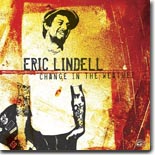 I
looked forward to kicking back and listening to the new album by Eric
Lindell, Change in the Weather, from the minute I realized
that Alligator records had sent it to me for review. I read Bruce
Iglauer’s introduction letter and I wanted to hear for myself why after
35 years in the business, Bruce would step outside of Alligator’s chosen
domain of blues and sign an artist whose music defies categorization.
What I find is a record that challenges me as a listener and in the end,
I agree with Bruce. Eric is an “old soul,” like blues the music he makes
is “soul healing” and I think we’re going to be hearing a lot more from
Eric in the future. So let’s get to the disc.
I
looked forward to kicking back and listening to the new album by Eric
Lindell, Change in the Weather, from the minute I realized
that Alligator records had sent it to me for review. I read Bruce
Iglauer’s introduction letter and I wanted to hear for myself why after
35 years in the business, Bruce would step outside of Alligator’s chosen
domain of blues and sign an artist whose music defies categorization.
What I find is a record that challenges me as a listener and in the end,
I agree with Bruce. Eric is an “old soul,” like blues the music he makes
is “soul healing” and I think we’re going to be hearing a lot more from
Eric in the future. So let’s get to the disc.
“Give It Time” starts out with a slow, laid back, blowing in the wind
kind of feel that immediately lets you know that Eric has been places
you’d like to go. Sometimes in life the best thing to do is just give it
time….faced with a difficult situation…it will get better….just “Give It
Time.” “Two Bit Town” samples the realities of small town life. Everyone
likes to gossip about their neighbor, the talk can get you down…Eric is
imploring his girl to “don’t let nobody take away your smile.” What’s
readily apparent two songs into this disc is that Eric has surrounded
himself with a very talented group of musicians to make this record. The
harp playing by Andy J. Forrest on “Two Bit Town” is soulful and stark
in its depiction of the loneliness of a small town.
“Feel Like I Do” finds Eric looking for affirmation of the love he feels
for his woman. She’s wonderful, she’s fine…but does she feel like he
does? The answer appears to be yes and Eric is one happy man. The tone
changes slightly on “All Alone.” Eric intones that after he finishes his
bottle of wine he going to take and spend some time with the girl he
fancies. “I may be high, I may be stoned, but darling as far as I can
see you’re all alone.” The horn section on “All Alone” is outstanding
and Jason Parfait contributes some outstanding sax work on this song.
“Should Have Known” finds Eric contemplating the fact that all is not
right with his current flame…”by the way you hold yourself I see…you’ve
been through misery…through the heartache and pain of love.” This one is
just going to take some time to make it right.
“Casanova” tells the tale of a ladies man from the past. Eric’s hoping
that his girl will let him slide on by and stay away from him. Eric’s
guitar lead on this song has a kind of funk groove to it and it’s very
appealing. Hopefully the girl will let Casanova “just slide on by.” “See
Me Through” is probably my favorite song on the disc. It’s a tale of
hard times and Eric’s appreciation that the love of his good woman will
“see me through.” The opposite occurs on “Sunny Daze,” lamenting the
fact that the good days are few and far between. Down on his luck, most
days are rainy days and Eric is hard pressed to just get out of bed.
Here’s hoping for better days.
“It Won’t Be Long” tells the tale of a woman who is working away from
home trying to provide for her family. “Mama’s always on the run and I
can tell she’s tired” One more day and one more night and then she
should be home. As the teller of the tale, if Eric had his way, “you’d
be here today.” On “Sad But True,” Eric is faced with the knowledge that
what everyone is saying about his woman is true….he’s been played for a
fool and it’s time to move on. “So many times I’ve played the fool…it’s
sad but true!”
Eric takes a different tact on “Let Me Know.” He’s found a woman that he
loves but she’s a mystery to him…he’s hoping that she will tell him what
he needs to know. “Let me know what to do…how to be your man.” We’re
just never sure he’s given the answer he’s seeking. “Uncle John” seems
to be a song of inquisitive redemption. Eric’s done a lot of things
wrong and he’s looking to Uncle John for the answers. “Uncle John…what
the hell’s going on….talk to your son.” He just never gets the response
he’s looking for.
“Lady Jane” is an ode to Eric’s on again off again love for Mary Jane.
“Something quick has got to change…..I can barely stand the pain…can’t
do without my Mary, Mary Jane.” Change In the Weather closes with
“Lazy Days.” Eric’s girl works too hard and won’t quit until she’s
finished the project she’s working on while Eric says…”we need a couple
of lazy days…drinking lemonade in the shade.” A perfect solution for
working too hard.
Change in the Weather is a unique album by what surely is a
unique artist. Eric Lindell does a masterful job of weaving blues, R&B
and Cajun influences, amongst others, into the context of an album that
grows on you with each spin in your CD player. Signing him to Alligator
records is definitely a departure for the label, but its easy see why
Bruce Iglauer felt it was something he needed to do. Rarely do we hear
new talent that challenges us musically on so many levels and Eric
Lindell is such a find. I look forward to hearing him live and
experiencing for myself the musical talents of this wonderful artist
from the Big Easy.
--- Kyle Deibler
Webster’s Dictionary defines fortuitous as: “happening by chance;
accidental.” The fact that the Mannish Boys' latest release,
Live & In Demand (Delta Groove Productions), is the result of such
circumstances is almost incomprehensible. The liner notes indicate that
the stars all fell into place at the Winthrop Blues Festival in
Washington. There just happened to be a professional recording crew on
site, the Mannish Boys were lighting it up, and someone was smart enough
to hit the record button. Considering the fact that recording the show
was an afterthought, we should all be as lucky to produce a live album
like this once in our lifetime. The end result is in a word, wonderful.
Kid Ramos kicks off the show with a self-penned instrumental, “Kid’s
Jump.” Supported by the rhythm section of Tom Leavey on bass and Richard
Innes on drums, Kid warms up the crowd with a blistering west coast
style jump that I’m sure had everyone on their feet and dancing. Randy
Chortkoff takes the lead on “I’m Ready” with his harp intro and then
displays his vocal talents on this Willie Dixon song. The band is very
tight and I find myself having a hard time believing you can record a
live album this clean. But the proof is in the disc and we can all
listen to it for ourselves.
Piano takes the lead with Leon Blue assuming vocal control of “She Wants
to Sell My Monkey.” Ramos trades instrumental solos with Leon as we
examine the reasons why his woman wants to sell his monkey. And lord
knows, “that will never do.” Johnny Dyer steps up to the microphone on
the classic “Mannish Boy.” With Chortkoff blowing wonderful harp leads
and Franck Goldwasser contributing slide guitar, Johnny gives a classic
interpretation of this Muddy Waters song. Dyer himself takes over the
harmonica chores on “You’re Sweet” and is supported by Blue on piano and
Goldwasser on lead guitar.
“Howling Wolf,” another Muddy Waters song, finds Goldwasser’s slide
guitar leading the way while Dyer lets us know that, “he’s a howling
wolf.” Slow, expressive, featuring intricate playing by Goldwasser and
Kid Ramos, Johnny lets us know that when he gets to howling, “I will
jump from limb to limb.” The leader of the Mannish Boys, Finis Tasby,
steps to the microphone to tell us about how his woman is “Goin Crazy
Over T.V.” He’s bought her a radio that “she hasn’t even listened to
yet”….she’d much rather watch Gunsmoke on TV. Finis is afraid that if
she doesn’t get over her tube addiction, ‘it’s going to run you blind.'
“Mystery Train” has Finis hoping that his woman is coming back. He
hasn’t had “any loving since his baby’s been gone” and is hopeful that
the mystery train coming round the corner will bring her back.
Chortkoff’s harmonica lead on “Mystery Train” has you imagining the
locomotive is right around the corner and you’re hoping for Finis’s sake
that she comes back. Things slow way down on the Freddie King song,
“It’s Too Bad.” Goldwasser gives us an inspired guitar lead on this song
that finds Finis down on his luck. It seems like now matter what he
touches…things will go bad. Goldwasser’s intricate playing more than
makes up for Finis’s depression as we explore the dark sides of his bad
luck.
The up tempo “Strangest Blues” has a mambo feel to it. His woman has
left him without saying a word and Finis is lost as to why. He
approaches her for some loving and she just leaves him behind. The
result is “the strangest blues that I’ve ever heard.” Next up is my
favorite song on the album, a rendition of Albert King’s “As The Year’s
Go Passing By.” It seems like everything just comes together on this
song. Finis’s vocals are the strongest of the set, Kid Ramos plays a
blistering guitar lead and the song just flows. You feel Finis’s pain as
he realizes that there isn’t “nothing I can do to change your love for
me.” This was a good woman he was in love with and it just didn’t work
out for him.
The set closes with “Walkin’ and Walkin’.” We find Finis out on the road
with no place to go…his solution is to get some religion and learn how
to pray. Hopefully the light will help him find his way.
With all of the perils and pitfalls that surround live recordings,
Live & In Demand stands out as a rare jewel. The Mannish Boys are a
wonderful collection of individual artists that stand out in their own
right but who come together to prove that the whole is still greater
than the sum of its parts. Their performance at the Winthrop Blues
Festival was tight, clean and exudes the professionalism that all of
these artists are known for. Kudos go out to whoever was smart enough to
hit the “record” button on the sound board. He or she saved for us a gem
that will stand on its own merits for a long, long time.
--- Kyle Deibler
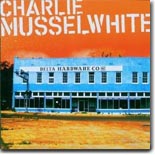 If there are any
blues fans out there who don’t consider Charlie Musselwhite
deserving of a spot in the pantheon of great blues harmonica players,
Delta Hardware will serve as strong evidence that they should
reconsider. Musselwhite’s latest release, his second for Real World, is
a raw and rugged return to basics, as he serves up ten powerful tracks
of stripped-down blues and boogie. Accompanied only by his three-piece
touring band of Chris “Kid” Anderson (guitar), Randy Bermudes (bass),
and June Core (drums), Musselwhite proceeds to bring the blues back home
to his native Mississippi, by way of Chicago, the Mississippi Hill
Country of R.L. Burnside, and the fertile ground of the Mississippi
Delta, plus adding a small dose of rock & roll to the mix as well.
If there are any
blues fans out there who don’t consider Charlie Musselwhite
deserving of a spot in the pantheon of great blues harmonica players,
Delta Hardware will serve as strong evidence that they should
reconsider. Musselwhite’s latest release, his second for Real World, is
a raw and rugged return to basics, as he serves up ten powerful tracks
of stripped-down blues and boogie. Accompanied only by his three-piece
touring band of Chris “Kid” Anderson (guitar), Randy Bermudes (bass),
and June Core (drums), Musselwhite proceeds to bring the blues back home
to his native Mississippi, by way of Chicago, the Mississippi Hill
Country of R.L. Burnside, and the fertile ground of the Mississippi
Delta, plus adding a small dose of rock & roll to the mix as well.
The
band kicks things off with a grungy rocker (“Church Is Out”), shifts to
a wild raver (Little Walter’s “One of These Mornings,” one of two Walter
Jacobs compositions on the disc), and mixes in a couple of Chicago
numbers (“Sundown,” “Just A Feeling,” and Billy Boy Arnold’s “Gone Too
Long”). Musselwhite, normally not one to discuss politics, also weighs
in with his take on some recent social concerns. The moody “Black
Water” and the Delta rocker “The Invisible Ones” both were inspired by
Hurricane Katrina and its devastating aftermath. Though expressing his
political views is not a standard practice for Musselwhite on record,
you certainly wouldn’t know it by these two songs as he does so in a
clear, succinct way.
My favorite track would have to be “Clarksdale
Boogie,” a longtime staple of Musselwhite’s live shows with a few new
twists thrown in. The band does an impressive job, particularly
Anderson whose guitar work serves as a perfect foil for Musselwhite’s
harmonica throughout the disc. Hard as it may be to believe, Charlie Musselwhite’s been putting out some great blues for
40 years (and
over 30 albums) and is continuing to raise the bar with each
release.
--- Graham Clarke
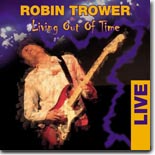 Way back in the
sixties, when Robin Trower made his debut recordings, he was
sometimes compared to Jimi Hendrix, but Trower’s sound has always been
his own, with roots both in the blues and the psychedelic guitar of that
era. Though he’s never stopped recording, he’s been under the radar for
a few years, except for his loyal following of fans that have never left
his side.
Way back in the
sixties, when Robin Trower made his debut recordings, he was
sometimes compared to Jimi Hendrix, but Trower’s sound has always been
his own, with roots both in the blues and the psychedelic guitar of that
era. Though he’s never stopped recording, he’s been under the radar for
a few years, except for his loyal following of fans that have never left
his side.
Recently, Trower released a live CD, his 25th
album overall, on the Ruf label, Living Out of Time-LIVE. Having
turned 60 the night of this appearance, Trower shows that he’s not lost
a step on guitar, playing with as much power and originality as he did
when he burst on the scene some forty years ago. For this live
appearance, recorded during the Rockpalast Crossroads Festival on March
9, 2005, Trower pulls out plenty of his older recordings, such as an
excellent take on his classic “Bridge of Sighs,” “Too Rolling Stoned,”
“Day of the Eagle,” and “Daydream,” along with more recent fare, such as
“Sweet Angel” and “Close Every Door.”
Teaming with Trower on this
release is Davey Pattison, who does a fantastic job on vocals, along
with Dave Bronze (bass, backing vocals) and Pete Thompson (drums), who
also provide stellar support. Leading the way is Trower, whose guitar
work is a wonder to behold over the entire 70-minute disc. There’s an
accompanying DVD of this show that was also released, but if you get the
chance to catch Robin Trower during his summer tour of the U.S., you
should not miss him. If you can’t, this CD is the next best thing.
--- Graham Clarke
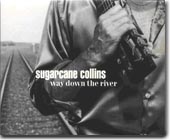 If you didn’t know
any better, listening to his new self-released disc Way Down the
River, you’d swear that Sugarcane Collins was raised on blues
music in the Deep South of the USA.But Collins is from a little further
south than that, Queensland, Australia. Blessed with a husky, soulful
voice and a deft stroke on guitar, Collins has played across much of
Australia for many years and made his first tour of the U.S. in 2005,
playing with Pinetop Perkins, Coco Montoya, W.C. Clark, and even
appearing on the King Biscuit Time Show with Sonny Payne in Helena,
Arkansas and at the Sunflower River Blues & Gospel Festival in
Clarksdale, MS (one of the great underrated festivals) while here.
If you didn’t know
any better, listening to his new self-released disc Way Down the
River, you’d swear that Sugarcane Collins was raised on blues
music in the Deep South of the USA.But Collins is from a little further
south than that, Queensland, Australia. Blessed with a husky, soulful
voice and a deft stroke on guitar, Collins has played across much of
Australia for many years and made his first tour of the U.S. in 2005,
playing with Pinetop Perkins, Coco Montoya, W.C. Clark, and even
appearing on the King Biscuit Time Show with Sonny Payne in Helena,
Arkansas and at the Sunflower River Blues & Gospel Festival in
Clarksdale, MS (one of the great underrated festivals) while here.
Way Down the River pays tribute to the great acoustic bluesmen of
the 20’s and 30’s, but not just as a period piece. Collins injects
electric bass and electric guitar, congas, and even a little organ on
selected tracks, so the ’20s and ’30s is more of a starting point with a
keen eye toward modern and even future blues. Collins wrote all the
tunes, and they are a powerful commentary on the music of that time.
Highlights include “Got A Mind To Ramble,” about the wanderlust that
struck so many residents of the Delta during that time in an effort to
improve their lot in life, “One Wing Frank,” about a prisoner who finds
a way out of the hard labor in the penitentiary, “Leadbelly,” a
biographical piece about the legendary Louisiana singer, and “Shine The
Light,” a stirring gospel track.
Two instrumentals, the rousing
washboard-propelled ragtime number “All The Way to St. Louis” and
“Dancing Rabbit Creek,” with its quirky use of Jew’s harp, showcase
Collins’ dynamic fretwork.
Fans of acoustic blues with a taste for
outstanding songwriting coupled with a few adventurous flourishes will
surely enjoy Way Down The River. o find out more about
Sugarcane Collins (and to purchase this remarkable disc at his secure
online shop), go to his website,
www.sugarcanecollins.com.
--- Graham Clarke
Fans of the ’80s
blues rock/soul group Billy (Vera) and the Beaters will find Rick
Hall & The Blue Healers’ new CD, To Tell The Truth, to be
just what the doctor ordered. Singer/guitarist Rick Hall has been
performing since his early teens and possesses a smooth vocal style and
some formidable chops on lead and slide guitar, as well as a knack for
writing distinctive songs in the soul/blues vein. Hall seamlessly mixes
his blues with soul, rock, and country and the results are sure to
please.
Highlights include the R&B tracks “Pay The Price,” “You Lied To
Me,” and “Give It Up,” along with the bluesier tracks “Do Right Man,”
“Blues Are Gonna Leave Me Too,” “This Old Guitar,” and “Goin’ Down
Fast.” Other standouts include “Ain’t Nothin’ But A Heartache,” which
has a country flavor to it, and the album’s lone cover, “You’re
Humbuggin’ Me,” which features a guest appearance on vocals by country
singer David Frizzell (whose brother Lefty was actually the first to
record the song back in 1958).
The band (Dave Fogle – Drums; Tom Martin
– Bass; Tim Davis – Keyboards, plus an outstanding horn section that
really adds flavor to several of the R&B tracks) provides exemplary
support for Hall. This is an impressive release and is definitely worth
a listen for R&B and blues fans. Stop by
www.cdbaby.com to pick up this cool disc, and for info on the band,
visit
www.rickhallblueshealers.com.
--- Graham Clarke
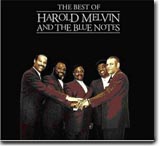 Fans of Harold
Melvin & the Blue Notes may be surprised to see a new release from
the band, given the fact that Melvin passed away almost ten years ago
(in 1997), but the group is still intact, and tours today as Harold
Melvin’s Blue Notes, mostly hitting the Oldies Circuit these days. However, during their heyday in the early
’70s, the Blue Notes were one
of the big soul acts, featuring Teddy Pendergrass served as their frontman. TP’s soulfully intense vocals powered the band through
multiple gold and platinum hits like “The Love I Lost,” “Bad Luck,” “If
You Don’t Know Me By Now,” “Wake Up Everybody,” and “Miss You” on the
Philadelphia International label.
Fans of Harold
Melvin & the Blue Notes may be surprised to see a new release from
the band, given the fact that Melvin passed away almost ten years ago
(in 1997), but the group is still intact, and tours today as Harold
Melvin’s Blue Notes, mostly hitting the Oldies Circuit these days. However, during their heyday in the early
’70s, the Blue Notes were one
of the big soul acts, featuring Teddy Pendergrass served as their frontman. TP’s soulfully intense vocals powered the band through
multiple gold and platinum hits like “The Love I Lost,” “Bad Luck,” “If
You Don’t Know Me By Now,” “Wake Up Everybody,” and “Miss You” on the
Philadelphia International label.
When Pendergrass left for a solo
career in the mid ’70s, so did the hit songs, but the group forged on
valiantly. St. Clair Entertainment recently released a new disc by the
current group, called The Best of Harold Melvin and The Blue Notes. Though the group’s hits are here, they are not the original versions,
but the Blue Notes’ current lead singer, Philadelphia native Donnell
“Big Daddy” Gillespie, has a gruff but tender style that is at times
reminiscent of Pendergrass and does an admirable job filling TP’s shoes.
The group harmonies are still pretty tight, but those lush
strings have been replaced by synthesizers.
Indeed, the group does
reproduce most of the hits, including the ones mentioned above, plus a
new version of the duet with Sharon Paige, “Hope That We Can Be Together
Soon,” with Paige (who has also become a member of the group) reprising
her original role. There are also cover versions of McFadden &
Whitehead’s “Ain’t No Stoppin’ Us Now,” the Spinners’ “Could It Be I’m
Falling In Love,” and the O’Jays’ “For The Love of Money.”
Newcomers to
the Blue Notes will probably want to get the Philadelphia International
era material first, but longtime fans of the group will enjoy finding
out that the group is still performing at a pretty high level.
--- Graham Clarke
Novice blues
collectors looking for an inexpensive way to pick up some familiar
tracks from notable blues musicians will find what they’re looking for
with The Best of The Great Blues Masters, another of St. Clair
Entertainment’s Essentials series. Longtime collectors will have
most of these songs in other formats, but the newbies among us will find
well-known songs from artists like B. B. King (“It’s My Own Fault,” “The
Thrill Is Gone,” and “How Blue Can You Get”), John Lee Hooker (“Boom
Boom,” “Crawlin’ Black Spider”), Buddy Guy (“First Time I Met The
Blues”), Lightnin’ Hopkins (“Have You Ever Loved A Woman”), Charles
Brown (“Driftin’ Blues”), and Canned Heat (“On The Road Again”).
Some
less familiar tunes present include a track by the great vocalist Gatemouth Moore (“Goin’ Down Slow”) and two live tracks from Ray Charles
(“Blues Is My Middle Name” and “Sittin’ On Top Of The World”).
As
stated above, chances are that you have most of these tracks (though
it’s not everyday you hear a Gatemouth Moore tune on a collection), but
newcomers to the blues on a tight budget will want to give this one a
spin. There’s not a clunker to be found in the bunch.
--- Graham Clarke
Another budget
compilation from St. Clair, The History of American Music: The Blues,
features a little something extra. While there are some great
recordings, both familiar (Muddy Waters’ “All Aboard,” a live take of Howlin’ Wolf’s “Howlin’ For My Darlin’,” Memphis Slim’s
“Memphis Slim U.S.A.,” and “T’aint Nobody’s Business If I Do,” by Bessie
Smith) and
are also some you may not have heard before, such as Lowell Fulson’s
“Every Day I Have The Blues,” Roosevelt Sykes’ “Night Time Is The Right
Time,” and “Honky Tonk Train Blues” by the legendary pianist Meade Lux
Lewis.
With 12 tracks in all, this may not be a definitive capsule
of the blues, but it is certainly a noteworthy cross-section covering the
early years of electric blues. Accompanying this collection is a DVD of
a movie made in the mid 1940s for the segregated all-black theatres of
the time. The movie, “Boarding House Blues,” is definitely one that
deserves to be remembered. Any movie that features the always-hilarious
Moms Mabley, Dusty Fletcher, Bullmoose Jackson, a one-armed and
one-legged dancer, and a guy dressed in monkey suit has to be worth
viewing.
Overall, this little collection boasts a lot of solid song
selections and is a nice addition to anyone’s blues collection.
--- Graham Clarke